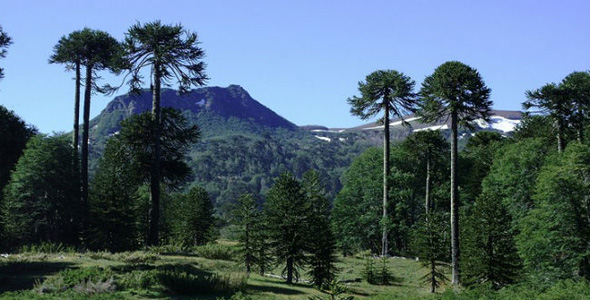Five native Chilean trees |
 In the words of Pablo Neruda, “He who has not visited the Chilean forests, hasn’t experienced this planet.” In Chile, you can find the second largest temperate forest in the world. It can also lay claim to incredible biological diversity, such as a number of native trees that can only be found in this country’s unique ecosystem. According to a report made by Conaf in 2011, arround 18% of Chile’s national territory is comprised of native forests and another 4% of foreign tree species, including the eucalyptus tree and the Douglas fir tree. It is believed that these percentages could increase in the future. What follows is a list of the five native trees in Chile, most characteristic of our country, one of which is practically extinct and can only be found on Easter Island, and which is now part of an important conservation project. Araucaria (Araucaria araucana) It’s the symbol of the Araucania Region in the south of Chile. Its trunk grows to incredible heights and gives birth to a gathering of branches in its upper section. It grows very slowly, but it can climb to 45m and live for around 1,000 years in the extreme conditions of The Andes. Various indigenous groups, in particular the Mapuche and Pehuenches, collect its seeds – known as pinions – to use in their traditional cooking recipes. The indigenous name of the tree is Pehuén and some English speakers refer to it as the Monkey-Puzzle tree. Alerce (Fitzroya cupressoides) Is one of the oldest trees in the world and lives for around 4,000 years, growing close to 50m high. In the last few years, it has played a leading role in an important conservation campaign that hopes to tackle the illegal logging of these trees – a problem caused by the great interest in the tree’s wood for construction and carpentry purposes. The Alerce Andino National Park in Puerto Montt is a place of historic growth that you can visit – a real jewel often overlooked, perfect for a one-day trip for anyone who likes the idea of walking through the Patagonia. Palma chilena (Jubaea chilensis) The natural habitat of the Chilean palm tree stretches from La Serena to Talca, but the palm tree can also be found in the south, in the Araucania Region and has been converted into a popular decorative plant further in the north. It’s believed that the Chilean palm tree is the oldest palm in the world, as well as being one of the tallest – reaching heights of up to 25m. Its distinctive smooth trunk is where Chile’s sweet secret lies… Palm tree honey. Unfortunately, the exploitation of the palm tree sap has brought about the deforestation of this particular tree species. Canelo (Drimys winteri) The beautiful, hard back of this tree is found in the center of Chile’s forests. The Canelo, whose cortex, leaves and roots possesses medicinal properties and is considered sacred by the Mapuche, Chile’s largest indigenous group. Thanks to these properties, the Canelo is planted on a regular basis in the Araucania Region and is a distinctive symbol of the Mapuche used in both social and religious gatherings. Most supermarkets across the country sell agüita de canelo – a herbal tea which helps to settle the stomach. Toromiro (Sophoro toromiro) The Toromiro escaped by a thread from extinction in Rapa Nui. When Capitan James Cook set anchor on the isolated island in the 1700s, he described the island as being covered by a small tree in bloom. 200 years later, the Toromiro was officially declared extinct on the island. A little later, thanks to the reforestation efforts of both Conaf and a local group, the Mata Ki Te Rangi (Eyes to the Sky), a small campaign has been organized to plant 80 seeds and distribute 300 more. Related News in Chinese: 你不知道的智利:盘点智利五大树种 Source: Touriso Chile |
|
http://news.travel168.net/20150525/36784.html |
Release Time:2015-05-25 16:02:00 |